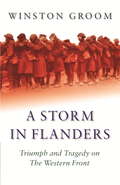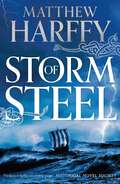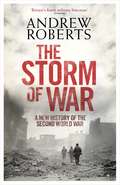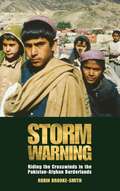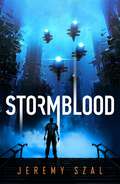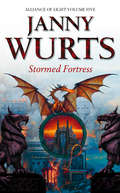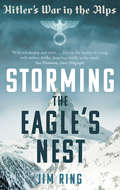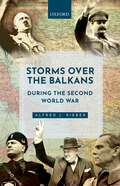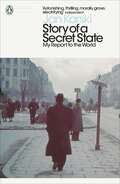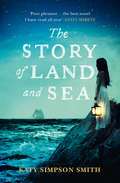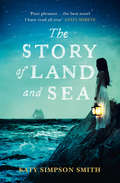- Table View
- List View
The Storm Dog (Winter Animal Stories Ser. (PDF) #6)
by Holly WebbTilly is going to stay with her gran and great-gran in Wales. She’s got a big school project about the Second World War to do and Gran, who was evacuated herself during the war, has promised to help. Travelling on the train for the first time alone, Tilly falls asleep and wakes up to discover she’s travelled all the way back to World War II. She’s being evacuated to Wales with her two younger brothers. Stern Mr Edwards offers to give them a home on his remote farm, where she meets a very special sheepdog…
Storm Force from Navarone: The Sequel To Alistair Maclean's Force 10 From Navarone
by Sam LlewellynThe surviving commandos are sent on a perilous journey through the Pyrenees to disable the greatest threat to the impending D-Day landings: the 'Werwolf' U-boats. But their Basque guides declare it mission impossible - D-Day is less than six days away.
Storm Front: The Extraordinary True Story Of A Secret War, The Sas's Greatest Battle, And The British Pilots Who Saved Them
by Rowland WhiteIn early 1970, the Commanding Officer of 22 SAS flew into the strategically critical Sultanate of Oman on a covert intelligence mission to monitor a Communist rebellion threatening the Arabian Peninsula. Within six months, the Regiment arrived in theatre to lead a fierce, secret war against the rebels, reinforced by an elite band of RAF pilots flying out of a remote airbase in the desert.But for the British soldiers and airmen, it was to be no easy victory. And despite confronting the largest assault force ever deployed by the SAS, many months later the enemy were still far from beaten. Something had to give.Then at dawn on July 19th, 1972, and without warning, a force of nearly 300 heavily armed, well-trained guerillas attacked the little fishing port of Mirbat. Between them and glory stood a team of just nine SAS men, aided only by the skill of the fighter pilots overhead. It was to be an epic encounter; a modern day Rorke's Drift. Their heroism that day would become SAS legend.
A Storm in Flanders: Triumph and Tragedy on the Western Front (Cassell Military Trade Bks.)
by Winston GroomA fast-paced and vivid narrative of the most horrific campaign in history: the four-year slaughter around the Belgian town of Ypres 1914-18. Switching seamlessly between the generals' headquarters, the politicians' councils and, above all, the mud and blood of the trenches, this is a wonderfully accessible history. Winston Churchill and Adolf Hitler both fought in the front line at Ypres: Groom reveals what happened to both men. We see the campaign through their eyes and the experience of other officers and men, including the war poet Edmund Blunden (later professor of poetry at Oxford). From the desperate defence put up by the tiny British regular army in 1914 to the infamous Passchendaele offensive, this is popular history at its best.
Storm of Eagles: The Greatest Aviation Photographs of World War II
by John Dibbs Kent Ramsey Robert Cricket" RennerSoaring high above the fields and cities of Europe and Asia as well as the vast expanse of the Pacific, Allied and Axis pilots engaged in a deadly battle for control of the skies in World War II. Whoever won the skies would win the war.Published in association with the National Museum of World War II Aviation, Storm of Eagles is a fully illustrated coffee-table book that brings together classic as well as never-before-seen wartime images. Compiled by one of the world's premier aviation photographers and historians, this remarkable volume is a must-have for anyone interested in World War II aviation.
Storm of Eagles: The Greatest Aviation Photographs of World War II
by John Dibbs Kent Ramsey Robert Cricket" RennerSoaring high above the fields and cities of Europe and Asia as well as the vast expanse of the Pacific, Allied and Axis pilots engaged in a deadly battle for control of the skies in World War II. Whoever won the skies would win the war.Published in association with the National Museum of World War II Aviation, Storm of Eagles is a fully illustrated coffee-table book that brings together classic as well as never-before-seen wartime images. Compiled by one of the world's premier aviation photographers and historians, this remarkable volume is a must-have for anyone interested in World War II aviation.
Storm of Steel: The Development of Armor Doctrine in Germany and the Soviet Union, 1919–1939 (Cornell Studies in Security Affairs)
by Mary R. HabeckIn this fascinating account of the battle tanks that saw combat in the European Theater of World War II, Mary R. Habeck traces the strategies developed between the wars for the use of armored vehicles in battle. Only in Germany and the Soviet Union were truly original armor doctrines (generally known as "blitzkreig" and "deep battle") fully implemented. Storm of Steel relates how the German and Soviet armies formulated and chose to put into practice doctrines that were innovative for the time, yet in many respects identical to one another.As part of her extensive archival research in Russia, Germany, and Britain, Habeck had access to a large number of formerly secret and top-secret documents from several post-Soviet archives. This research informs her comparative approach as she looks at the roles of technology, shared influences, and assumptions about war in the formation of doctrine. She also explores relations between the Germans and the Soviets to determine whether collaboration influenced the convergence of their armor doctrines.
Storm of Steel (The Bernicia Chronicles #6)
by Matthew HarffyAD 643. Anglo-Saxon Britain. A gripping, action-packed historical thriller and the sixth instalment in the Bernicia Chronicles. Heading south to lands he once considered his home, Beobrand is plunged into a dark world of piracy and slavery when an old friend enlists his help to recover a kidnapped girl.Embarking onto the wind-tossed seas, Beobrand pursues his quarry with single-minded tenacity. But the Whale Road is never calm and his journey is beset with storms, betrayal and violence.As the winds of his wyrd blow him ever further from what he knows, will Beobrand find victory on his quest or has his luck finally abandoned him?Praise for Matthew Harffy: 'Nothing less than superb... The tale is fast paced and violence lurks on every page' Historical Novel Society'Beobrand is the warrior to follow' David Gilman'A tale that rings like sword song in the reader's mind' Giles Kristian'Historical fiction doesn't get much better than this' Angus Donald'A brilliant characterization of a difficult hero in a dangerous time. Excellent!' Christian Cameron'A terrific novel. It illuminates the Dark Ages like a bolt of lightning' Toby Clements'Battles, treachery, revenge and a healthy dose of Dark Age adventure' Simon Turney'Matthew Harffy tells a great story' Joanna Hickson'Harffy's writing just gets better and better... He is really proving himself the rightful heir to Gemmell's crown' Jemahl Evans'Harffy has a real winner on his hands... A genuinely superb novel' Steven McKay'A breathtaking novel that sweeps the reader into a dark and dangerous world' Paul Fraser Collard
Storm of Steel (Penguin Modern Classics)
by Ernst Junger'As though walking through a deep dream, I saw steel helmets approaching through the craters. They seemed to sprout from the fire-harrowed soil like some iron harvest ...'Storm of Steel is one of the greatest works to emerge from the catastrophe of the First World War. A memoir of astonishing power, savagery and ashen lyricism, it illuminates like no other book the horrors but also the fascination of total war, presenting the conflict through the eyes of an ordinary German soldier. As an account of the terrors of the Western Front and of the sickening allure that made men keep fighting on for four long years, Storm of Steel has no equal.
The Storm of War: A New History of the Second World War (Playaway Adult Nonfiction Ser.)
by Andrew RobertsOn 2 August 1944, in the wake of the complete destruction of the German Army Group Centre in Belorussia, Winston Churchill mocked Adolf Hitler in the House of Commons by the rank he had reached in the First World War. 'Russian success has been somewhat aided by the strategy of Herr Hitler, of Corporal Hitler,' Churchill jibed. 'Even military idiots find it difficult not to see some faults in his actions.' Andrew Roberts's previous book Masters and Commanders studied the creation of Allied grand strategy; Beating Corporal Hitler now analyses how Axis strategy evolved. Examining the Second World War on every front, Roberts asks whether, with a different decision-making process and a different strategy, the Axis might even have won. Were those German generals who blamed everything on Hitler after the war correct, or were they merely scapegoating their former Führer once he was safely beyond defending himself? In researching this uniquely vivid history of the Second World War Roberts has walked many of the key battlefield and wartime sites of Russia, France, Italy, Germany and the Far East. The book is full of illuminating sidelights on the principle actors that bring their characters and the ways in which they reached decisions into fresh focus.
Storm Warning: Riding the Crosswinds in the Pakistan-Afghan Borderlands
by Robin Brooke-SmithThe Afghan-Pakistan Borderlands are pivotal to international security. They are often dangerous, strategically crucial and little explored by outsiders. Robin Brooke-Smith provides a new perspective on Northwest Pakistan in this first-hand account of his years in this troubled region. Tracing the build-up to 9/11 and the upheaval that has followed, this is a captivating behind-the-scenes look into the regional fulcrum of global jihad.Recounting his experiences as Principal of the prestigious Edwardes College in Peshawar, the author explores the creation and growing influence of the Taliban and other extremist groups, and the complicity of the military in their development. Brooke-Smith provides a unique and close-up view into this fascinating area, from personal dealings with senior figures in the notorious ISI Military Intelligence, to giving a voice to the young people of Peshawar. An enthralling and distinctive analysis on the state of the borderlands – and its possible future – this book is illuminating reading for all those interested in Pakistan, Afghanistan and the turbulent recent history of the 'AfPak' region.
Stormblood
by Jeremy SzalVakov Fukasawa used to be a Reaper: a bio-enhanced soldier fighting for the Harmony, against a brutal invading empire. He's still fighting now, on a different battlefield: taking on stormtech. To make him a perfect soldier, Harmony injected him with the DNA of an extinct alien race, altering his body chemistry and leaving him permanently addicted to adrenaline and aggression. But although they meant to create soldiers, at the same time Harmony created a new drug market that has millions hopelessly addicted to their own body chemistry. Vakov may have walked away from Harmony, but they still know where to find him, and his former Reaper colleagues are being murdered by someone, or something - and Vakov is appalled to learn his estranged brother is involved. Suddenly it's an investigation he can't turn down . . . but the closer he comes to the truth, the more addicted to stormtech he becomes.And it's possible the war isn't over, after all . . .
Stormed Fortress: Fifth Book of The Alliance of Light (The Wars of Light and Shadow #8)
by Janny WurtsThe spellbinding final instalment of The Alliance of Light.
Storming Monte La Difensa: The First Special Service Force at the Winter Line, Italy 1943 (Raid)
by Peter Dennis Johnny Shumate Bret Werner Alan GillilandIn December 1943 Monte La Difensa was part of the formidable German defences overlooking the Allies' planned route to Rome via Monte Cassino. In the First Special Service Force's first combat in the Mediterranean theater, the Force would employ its special training in mountain and winter warfare to scale the peak, capture it, and then hold it against the inevitable German counterattacks. Astonishing their superiors, the First Special Service Force succeeded in the face of seemingly impossible odds, but suffered a 77 percent casualty rate. Their victory, founded on their aggressive doctrine and extensive training in a variety of combat techniques, would prove instrumental in the postwar development of special forces. Employing full-colour artwork, archive photographs, and first-hand accounts from participants, the author examines the origins, execution, and aftermath of the FSSF's spectacular success at Monte La Difensa amid the savage winter conditions of December 1943.
Storming Monte La Difensa: The First Special Service Force at the Winter Line, Italy 1943 (Raid #48)
by Peter Dennis Johnny Shumate Bret Werner Alan GillilandIn December 1943 Monte La Difensa was part of the formidable German defences overlooking the Allies' planned route to Rome via Monte Cassino. In the First Special Service Force's first combat in the Mediterranean theater, the Force would employ its special training in mountain and winter warfare to scale the peak, capture it, and then hold it against the inevitable German counterattacks. Astonishing their superiors, the First Special Service Force succeeded in the face of seemingly impossible odds, but suffered a 77 percent casualty rate. Their victory, founded on their aggressive doctrine and extensive training in a variety of combat techniques, would prove instrumental in the postwar development of special forces. Employing full-colour artwork, archive photographs, and first-hand accounts from participants, the author examines the origins, execution, and aftermath of the FSSF's spectacular success at Monte La Difensa amid the savage winter conditions of December 1943.
Storming the Eagle's Nest: Hitler's War in the Alps
by Jim RingFrom the Fall of France in June 1940 to Hitler's suicide in April 1945, the swastika flew from the peaks of the High Savoy in the western Alps to the passes above Ljubljana in the east. The Alps as much as Berlin were the heart of the Third Reich.'Yes,' Hitler declared of his headquarters in the Bavarian Alps, 'I have a close link to this mountain. Much was done there, came about and ended there; those were the best times of my life . . . My great plans were forged there.'With great authority and verve, Jim Ring tells the story of how the war was conceived and directed from the Fuhrer's mountain retreat, how all the Alps bar Switzerland fell to Fascism, and how Switzerland herself became the Nazi's banker and Europe's spy centre. How the Alps in France, Italy and Yugoslavia became cradles of resistance, how the range proved both a sanctuary and a death-trap for Europe's Jews - and how the whole war culminated in the Allies' descent on what was rumoured to be Hitler's Alpine Redoubt, a Bavarian mountain fortress.
Storming Vicksburg: Grant, Pemberton, and the Battles of May 19-22, 1863 (Civil War America)
by Earl J. HessThe most overlooked phase of the Union campaign to capture Vicksburg, Mississippi, was the time period from May 18 to May 25, 1863, when Ulysses S. Grant closed in on the city and attempted to storm its defenses. Federal forces mounted a limited attack on May 19 and failed to break through Confederate lines. After two days of preparation, Grant's forces mounted a much larger assault. Although the Army of the Tennessee had defeated Confederates under John C. Pemberton at Champion Hill on May 16 and Big Black River on May 17, the defenders yet again repelled Grant's May 22 attack. The Gibraltar of the Confederacy would not fall until a six-week siege ended with Confederate surrender on July 4. In Storming Vicksburg, military historian Earl J. Hess reveals how a combination of rugged terrain, poor coordination, and low battlefield morale among Union troops influenced the result of the largest attack mounted by Grant's Army of the Tennessee. Using definitive research in unpublished personal accounts and other underutilized archives, Hess makes clear that events of May 19–22 were crucial to the Vicksburg campaign's outcome and shed important light on Grant's generalship, Confederate defensive strategy, and the experience of common soldiers as an influence on battlefield outcomes.
Storms over the Balkans during the Second World War
by Alfred J. RieberIn a new interpretation of the history of the Balkans during the Second World War, Alfred J. Rieber explores the tangled political rivalries, cultural clashes, and armed conflicts among the great powers and the indigenous people competing for influence and domination. The study takes an original approach to the region based on the geography, social conditions, and imperial rivalries that spans several centuries, culminating in three wars during the first half of the twentieth century. Against this background, Rieber focuses on leadership - personified by Mussolini, Hitler, Stalin, Churchill, and Tito - as the key to explaining events. For each one the Balkans represented a strategic prize vital for the fulfilment of their ambitious war aims. For the local forces the destabilization of the war offered the opportunity to reorder societies, expel ethnic minorities, and expand national borders. Storms over the Balkans during the Second World War illustrates how the leaders of the external powers were forced to improvise their tactics and compromise their ideologies under the pressure of war and the competing claims of their allies and clients. Neither the Axis nor the Allied camps were uniform blocs, and deep divisions ran through the ranks of the resistance and those collaborating with the occupying powers. These tensions contributed to the failure of all the participants in the struggle to achieve their aims. The complexities of the wartime experiences help to explain the persistence of memories and unfulfilled aspirations that continue to haunt the region. The study is based on extensive research in new sources in seven languages.
Storms over the Balkans during the Second World War
by Alfred J. RieberIn a new interpretation of the history of the Balkans during the Second World War, Alfred J. Rieber explores the tangled political rivalries, cultural clashes, and armed conflicts among the great powers and the indigenous people competing for influence and domination. The study takes an original approach to the region based on the geography, social conditions, and imperial rivalries that spans several centuries, culminating in three wars during the first half of the twentieth century. Against this background, Rieber focuses on leadership - personified by Mussolini, Hitler, Stalin, Churchill, and Tito - as the key to explaining events. For each one the Balkans represented a strategic prize vital for the fulfilment of their ambitious war aims. For the local forces the destabilization of the war offered the opportunity to reorder societies, expel ethnic minorities, and expand national borders. Storms over the Balkans during the Second World War illustrates how the leaders of the external powers were forced to improvise their tactics and compromise their ideologies under the pressure of war and the competing claims of their allies and clients. Neither the Axis nor the Allied camps were uniform blocs, and deep divisions ran through the ranks of the resistance and those collaborating with the occupying powers. These tensions contributed to the failure of all the participants in the struggle to achieve their aims. The complexities of the wartime experiences help to explain the persistence of memories and unfulfilled aspirations that continue to haunt the region. The study is based on extensive research in new sources in seven languages.
Story of a Secret State: My Report to the World (Penguin Modern Classics)
by Jan Karski'I do not pretend to have given an exhaustive picture of the Polish Underground, its organization and its activities.Because of our methods, I believe that there is no one today who could give an all-embracing recital...This book is a purely personal story, my story.'Jan Karski's 1944 war memoir is a heroic act of witness: the courageous testimony of a man who risked everything for his country. At times overwhelming in the details it reveals of the suffering of ordinary people, it is an unforgettable and deeply affecting record of brutality, courage, and survival under conditions of extreme bleakness. During the first four years of World War II, Karski worked as a messenger for the underground, risking his life in secret missions. He was captured, tortured, rescued, smuggled through a tunnel into the Warsaw ghetto and, finally, disguised himself as a guard to infiltrate a Nazi death camp. Then, travelling across occupied Europe to England, with his eye-witness report smuggled on microfilm in the handle of a razor, he became the first man to tell the Allies about the Holocaust - only to be ignored.
The Story of Beatrix Potter (National Trust History And Heritage Ser.)
by Sarah Gristwood“Sumptuous…a fitting legacy for a pioneering conservationist who helped save thousands of acres of the Lake District” – The Mail on Sunday, August 2016
The Story of Black Military Officers, 1861-1948 (Routledge Studies in African American History)
by Krewasky A. Salter IBlack members of the military served in every war, conflict and military engagement between 1861 and 1948. Beyond serving only as enlisted soldiers and non-commissioned officers, many also served as commissioned officers in positions of leadership and authority. This book offers the first complete and conclusive work to specifically examine the history of black commissioned officers.
The Story of Black Military Officers, 1861-1948 (Routledge Studies in African American History)
by Krewasky A. Salter IBlack members of the military served in every war, conflict and military engagement between 1861 and 1948. Beyond serving only as enlisted soldiers and non-commissioned officers, many also served as commissioned officers in positions of leadership and authority. This book offers the first complete and conclusive work to specifically examine the history of black commissioned officers.
The Story of Land and Sea
by Katy Simpson SmithA lyrical and spellbinding story of love, loss, and war from a standout new voice in fiction. Katy Simpson Smith has already been acclaimed as an ‘heir apparent to to Michael Ondaatje and Marilynne Robinson’
The Story of Land and Sea
by Katy Simpson SmithA lyrical and spellbinding story of love, loss, and war from a standout new voice in fiction. Katy Simpson Smith has already been acclaimed as an ‘heir apparent to to Michael Ondaatje and Marilynne Robinson’



